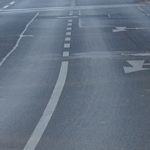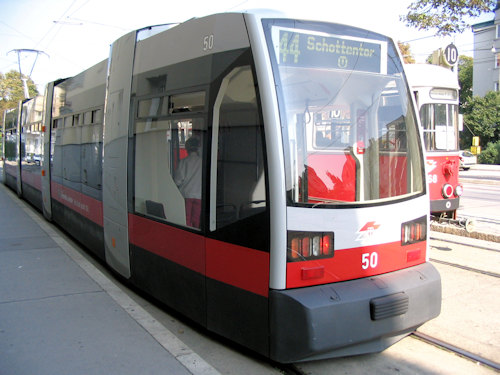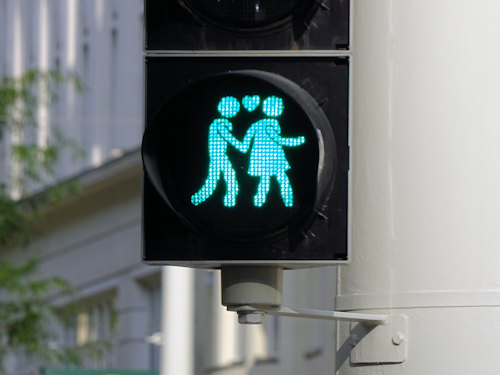
Coming from the UK system, many things “surprised” me a little about driving a car in Vienna. Enjoy some extra tips for a safer and more enjoyable road experience, many of which I learned the hard way…
- Switch to public transport with a Vienna Welcome Card* travel pass
- See also:
The Austrian authorities provide a lot of useful information in English about driving laws and similar: read up on local traffic regulations here and here for starters. Consider the following as merely bonus advice…
1. Respect trams

(The mighty tram)
Worship trams. Respect them as the Gods of the road. Ask for their blessing on entering your vehicle. And, most importantly, don’t get in their way.
Obviously, if the tram line uses the same road lane you’re on, you’re not obliged to pull over just to let the tram pass.
But if you’re otherwise blocking a tram, get out of the way as quickly as safely possible. Trust me on this. It’s also a legal requirement.
Trams are subject to different road rules: they have no obligation to stop at zebra crossings, for example, if someone’s waiting to cross. And you can assume they have priority, whichever direction they’re coming from.
2. Be careful at tram (and bus) stops

(One of the newer tram/bus stop signs)
You might find yourself on a bit of road between a tram line and its tram stop. Which means people leaving or boarding the tram need to cross your lane to do so.
If a tram is approaching such a stop on your side (or is already parked there), you must slow down and stop to allow people to leave or board.
You may only drive off again and pass the tram once the tram moves off or once the coast is completely clear (nobody leaving the tram, nobody boarding or looking to board, and the tram doors have all closed).
The best advice is simply to remain stationary until the public transport vehicle actually moves away.
3. Priority to the right
Vehicles coming from the right have priority, as in much of mainland Europe.
It means, for example, if you’re driving and approaching a road leading off to the right, you must allow vehicles coming from that road to cross or otherwise enter your road.
This does not apply, for example, if the road from the right has a “give way” or “stop” sign managing access to your road, or if you’re on a clearly-marked priority road (“Vorrangstraße”).
In practice, traffic lights and road signs regulate most junctions in Vienna. But be especially careful if using residential or side roads, as this is where this rule comes into play most often.
4. Be wary on roundabouts
People here are still getting used to roundabouts, which represent a rare and somewhat mysterious concept for many locals. In particular, indicator discipline can be poor, so be extra careful.
5. Watch for cyclists on one-way streets
Use of cycles has risen significantly in recent years, so be aware of cycle lanes and two-wheeled traffic.
Some one-way streets have cycle lanes that go against the flow of traffic. This is something to particularly watch for when turning onto a one-way street since you have to look both ways (you should see appropriate warning signs).
6. Take care turning at traffic lights

(The rare couples pedestrian crossing lights)
If turning left or right at traffic lights, be careful of pedestrians crossing at the same junction: they may have priority right of way, even if your lights are green.
7. Don’t use dedicated bus lanes during their hours of operation
This seems obvious. But you might be lured into doing so by the presence of other cars going down those lanes. However, these are probably taxis, which are allowed to use the bus lanes.
8. Don’t expect special treatment
If you have foreign number plates, don’t expect other drivers to cut you some slack and show more than the usual amount of patience or understanding. Not because they’re unfriendly, but simply because you’re not at all unusual.
Vienna has lots of cars without Viennese or Austrian number plates, given the city’s international population, location in the middle of Europe on an east-west transit route, and closeness to other countries like Slovakia.
Want to know the smallest measurable unit of time in the Viennese driving universe? It’s the time between the lights going green and the car behind you using their horn to kindly point this out to you.
9. Don’t assume it’s right just because others do it
A small minority of drivers in Vienna take a rather loose view of things like speed limits and pedestrian rights.
Driver discipline at zebra crossings, for example, tends to be much looser than in the UK, despite similar rules.
10. Drive on the right
Not a surprise, but not something to forget (um, obviously).
Curiously, people used to drive on both the left and right in Austria depending on which province you found yourself in. The whole country only switched to the right following the unfortunate (to say the least) Anschluss with Nazi Germany in 1938.
→ Find more tips on driving and parking in Vienna.